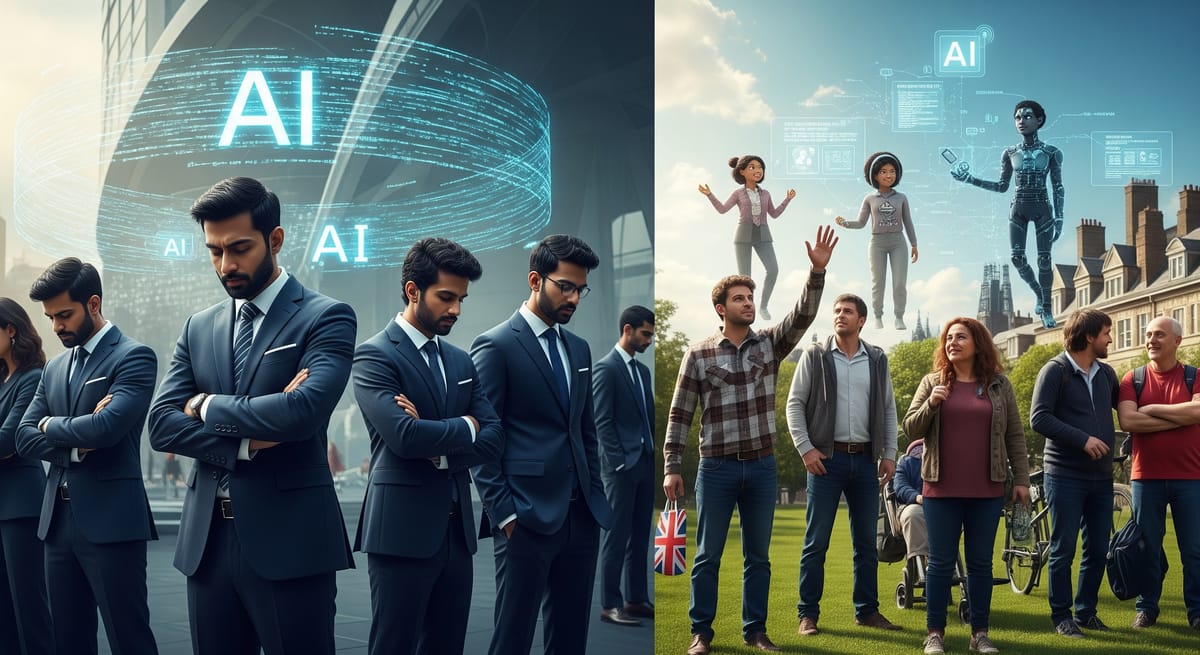Power and incentives: Web3 and decentralized AI

The problem of AI is the problem of power. This does not mean power in the energetic sense – though that certainly is a problem, and one with stark implications for electricity grids and water supplies. Instead, it refers to human power – the power we humans, operating in our companies, countries, and collectives – wield over one another. AI changes power relationships. It changes the relationship between different people, the relationship between different companies, and the relationships between different states. A world dominated by the AI capabilities of a few companies and countries is a world that will be less free and less equal for the majority.
A handful of companies dominate AI, and they sit in only a handful of countries. Through their platforms, tech giants like Google, Apple, Amazon & Baidu control their vast datasets, distribution systems, and customer networks; for some years, they have been using AI to build new products and extract more value. Breakout AI giants like OpenAI, Perplexity et al are, meanwhile, striving to dominate the emerging space of AI-powered applications through developing and commercializing their foundation models. Most of the leading AI companies are in either the USA or China, handing the governments of these countries immense potential power over everyone else.
The pillars of AI power
Pillar 1: Data. This power is based on access to data, models, and compute infrastructure. Data and AI are intimately linked. For several years , it was a LinkedIn truism that ‘Data is the new oil’. It is a flawed analogy – data, unlike oil, doesn’t burn on use, and it is a potentially limitless resource. At the same time, oil is produced in only a few regions; if you have the sensors and platforms to generate and collect it, data is everywhere. The pervasive digitisation of everyday consumer and business life has created new layers of economic interaction, and new fields of value. Every interaction you take using a digitally-enabled system – scrolling on your smartphone, connecting with people on Telegram or Linkedin, ordering food via UberEats – creates data. Given the salience of this data to business and operating decisions, this means in turn that control over data and the use of data creates new forms of power and influence. The last 20 years of consumer technology development thus already gave tech giants vast influence over how we live, work, and play; AI promises to supercharge this.
Pillar 2: Models. The development of ever better and higher performance AI models is a central task of the industry. Model training, especially the training of foundation models, requires enormous datasets; these are obtained through scraping the public internet, licensing (or pirating) books, archives, and academic journals, and from utilizing product data such as that created by the users of Gmail, Facebook, or LinkedIn. Data is used to train AI models; these models are then used to analyse, infer, and automate on the basis of data. The tech majors can tap massive proprietary datasets, and use their wealth to buy and access even more.
Pillar 3: Infrastructure. Access to compute is the third element of AI power. Compute is a bottleneck for scaling model size and performance; training AI models like GPT-4 or Gemini requires thousands of GPUs running for weeks or months. While cloud services offer AI compute, pricing is high and access is often rationed. Access to high-end computer clusters is limited to the well-funded - tech giants, wealthy startups, nation states. Demand for AI is also prompting larger and larger datacentres; Meta’s new data facility, Hyperion, will be almost as large as Manhattan Island. This single data centre will consume 5 GW of energy, an amount that compares to a global city; at peak requirement, London consumes 6GW.
AI is a socio-technical system, which is to say it is one developed through the interactions of both technology, and the social forms – companies, culture, groups of people – who use that technology. People use technology in a variety of ways. Organisations that make or manage digital technologies in particular will tend to be driven by three primary motivations – the urge to profit, the urge to predict, and the urge to control. On that basis, the gigantic multinationals and two or three foreign governments cannot be presumed to act in the interests of the global majority. This creates a problem, for the current pattern of access to training data, models, and computing infrastructure means that AI is highly centralized.
Broadly speaking, centralised AI creates several problems:
- Power: As outlined above, it concentrates power in a handful of companies, with large economic and political effects
- Economic returns: the winner takes all dynamic of digital life may mean that gigantically disproportionate returns will accrue to the owners of AI systems. Given the likely scale and velocity of job losses related to AI, this is a big problem. Think of all the workers and small businesses, automated away. Who will own the systems that have outcompeted them? How, if at all, are the gains to be redistributed? As recent British debates on intellectual property highlight, this question touches all elements of economic, intellectual and creative life.
- Governance: Who controls the controllers? Where influence over extremely powerful and highly distributed AI systems is limited to a few individuals, everyone else is in thrall to their priorities, preoccupations, and whims.
- Privacy & security: Centralised repositories of sensitive information are vulnerable to attack and misuse. Gigantic datacentres, meanwhile, are vulnerable to physical attacks.
- Democratic control: lack of privacy, gigantic economic disruption, and the changed power differentials means that centralised control of AI poses a massive problem for democracy
Where power is concentrated in a few companies and governments, and with technology creating huge changes in economic and political life, our previous concepts of freedom and democracy are increasingly at risk. To spread the benefits of AI, and to protect human freedom, AI must be decentralized
What is decentralised AI?
Decentralised AI refers to the development, training, and operation of artificial intelligence systems using distributed networks — often enabled by blockchain technology or peer-to-peer protocols — in ways that reduce dependency on centralised institutions.
It stands in contrast to the current centralized paradigm, where AI models are trained and deployed by centralised entities (like OpenAI, Google, Meta, Microsoft), compute is hosted in centralised data centres (such as AWS, Azure, GCP), and data is harvested from users without meaningful control or compensation
By contrast, decentralised AI aims to:
- Distribute training and inference workloads across networks of independent participants
- Allow data providers to retain control over how their data is used
- Reward open collaboration through crypto-economic incentives
- Enable communities to govern AI systems transparently and democratically
In the words of MIT Media Lab, “Decentralized AI enables collaboration between such entities with complementary assets, such as data and computation, without requiring central oversight.”
‘Decentralised AI’ thus describes a set of technical architectures and a political-economic agenda for resisting AI monopolies and preserving individual and collective agency in the age of intelligent machines. Decentralised AI is motivated by efforts to build:
Decentralised data: Solutions that ensure data remains and controlled by individual data subjects, organisations, and sub-organisation, yet can also be accessed, exchanged, and transacted upon. Data silos currently prevent organisations from making the most of the data they have, or from sharing that dat with others; decentralized paradigms can resolve this.
Decentralized compute: Democratising access to computing resources, typically through access to networks of devices with limited individual capacity. Solutions may include systems utilising the compute capacity of mobile phones, laptops, or other edge devices.
Decentralised coordination: Decentralised systems that avoid reliance on any central set of actors. Decentralised AI can be an overlay network, facilitating coordination between different entities.
Source: A Perspective on Decentralising AI, MIT Media Lab, 2024
The benefits of decentralised AI
Use AI over siloed data: Many industries and companies have fragmented data, split between geographies and internal siloes. Decentralised AI provides the tools, protocols, systems, and incentives to ensure that individuals, organisations and sub-organisational groups can use this data to collaborate, without sacrificing data privacy. By doing so, it unlocks new forms of value, and new business models.
Incentivised and participatory AI: DeAI business models, platforms, and practices mean that the owners of decentralised resources - individual data owners, for instance - can gain value. By rewarding participants who securely share their private data or compute capacity, these business models ensure people are incentivised to participate.
Collaborative and responsible AI: decentralised ecosystems promote transparency, plurality, and verifiability. As a result it promoted better governance. At the same time, distribution of resources and control heps mitigate the risk off any single catastrophic point of failure.
Improved accessibility of resources: Many data sets and computing resources cannot currently be used, because there are no mechanisms by which they can be shared. Decentralised AI provides a way of integrating disparate datasets, and using underutilised compute. Some decentralised AI projects focus, for instance, on opening up consumer laptops and mobile phones as shared compute resources.
Operationalising decentralised AI: the 4 challenges
For decentralised AI to work it must address challenges across 4 areas.
- Privacy. User trust and organisational buy-in require that data privacy be maintained. Current approaches rely on trusted and centralised data brokers; for decentralised AI to work, it needs ways of achieving secure computation over decentralised data
- Verifiability: Privacy is important, but a successful DeAI system also needs to be able to verify the credentials of participants. If it does not, it may be flooded by bad actors; without accountability, anonymity can enable them to degrade, undermine, and abuse the system. Algorithms and collaboration need to transfer from trusted and permission-based systems to trustless alternatives - ones where legitimate contributions can be proved by contributors and verified by other participants.
- Incentives: To create a brokerless system, one that does not depend upon the centralised data and compute capability of tech giants. To achieve this, effective data markets must be created to incentivise the sharing of siloed data sets. Methods of valuing data must be achieved in order to facilitate these data transactions, and they must enable these valuations to occur in a private and trustless way. Sellers must know that the data they share is not copied without permission or otherwise used incorrectly, and in order to achieve scale, valuation algorithms must be cheap to compute; privacy, security, and efficiency must be maintained over data and data transactions. Successful DeAI systems must also include mechanisms to enable the consented sharing of data, and new forms of governance to manage the data sources, marketplaces, and transactions.
- Orchestration: DeAI requires a coordinationless system where networks of individuals and communities can self-organise and connect autonomously. Successful DeAI must deal with the highly heterogeneous nature of data and AI models. It must also enable the decentralized selection of collaborators based on historic performance and resource availability. Given geographical distribution and varying nature of data, it must also allow for synchronous model training.
Where web3 comes in
The cause of decentralised AI can be advanced using several different approaches. Federated learning enables training on decentralized data, though it relies upon centralised orchestration and couples data ownership and computation ownership. Distributed AI approaches enable parallelisation and distribution of AI tasks such as training and inference across multiple machines. Among other things, this facilitates scaling of deep learning across data centres. However, it often requires some central control, and can have scalability bottlenecks. Open source software and open access data enable distributed collaboration, but machine learning requires access to data, compute, and network infrastructure that often cannot be open-sourced. Other mechanisms and systems are needed to advance decentralised AI, and that is where web3 comes in.
Web3 based approaches to decentralized AI focus on incentives, verifiability, and attribution.
Attribution & ownership: Blockchain based systems can be used as a decentralised mechanism to verify who owns and has rights over resources. This can include datasets, bits of IP - any resource that one party is looking to share. This, in turn, means that resource owners can be better incentivised to share their property and /or excess capacity. Story, an IP-focused layer 1, allows creators to tokenise and trade their IP.
Verification of use, permissions, and contributions: Blockchain architectures mean that it is easier to see when a particular resource has been accessed. This could be for any purpose. Decentralised and open ledgers can be used to demonstrate when a body of academic research journals has been used to train an AI model, or show that a music deApp user has listened to a particular song. In both cases, this makes it easier for rights-owners to know who has been using their material, and gain economic reward for this. Similarly, blockchain-based permissions assist with ensuring that users of a system are authenticated and given permissions to access resources, without requiring central coordination or identification.
Incentivisation: Web3 approaches help with incentivizing people to share resources. Tokens can be used to incentivise people for sharing resources like dataset and compute, or for otherwise contributing to the health of a market. Acurast users, for instance, are given cACU tokens for offering up the computational resources of their smartphone for those seeking to do edge computing.
Together, improved attribution, verification, and incentivisation produce second order outcomes like functional markets in decentralized data and compute
This leads to, for instance:
Data markets: the free exchange of data is fundamental to AI and fundamental to decentralized AI. Using blockchain based systems, data owners can prove they own data, verify who has been using it and, using smart contracts, set controls on how that data is being used. Combined with token based incentives systems, and blockchain helps creates the conditions for trusted and liquid markets in decentralised data exchange. It also helps with markets for data related tasks, like labelling datasets and fine-tuning models.
Sharing computational resources: As with data markets, the conjunction of systems that can prove attribution and ownership, verify credentials, and incentivise participation - all in a decentralized manner - enable the sharing of computational resource
Changed access to models & inference: A range of new operating and commercial modalities are opened up for the training and use of AI models. Venice AI, a privacy-first ChatGPT equivalent , uses its crypto token to determine how much inference an individual user or app may have per day. By staking a percentage of VVV tokens, users can gain access to an equivalent amount of Venice’s overall capacity that day.
What are the tokens for?
As any degen will tell you, tokens are at the core of crypto. Taken on a more serious level, the value of blockchain tokens lies in enabling the economic incentivisation of DeAI. They can be used to reward people for sharing data and other resources. They can be used to reward people for contributing their time and effort to building and maintaining DeAI protocols and tools, or for doing such AI relevant tasks as labelling datasets. They play an important role in fundraising and community engagement. Tokens can also be used to fractionalise ownership and usage rights over resources, enabling them to be better shared and exploited. The flexibility and programmability of tokens, meanwhile, means that incentives, permissions, and controls relating to deAI resources and systems can be structured in all sorts of ways. In short, without the economic opportunities opened up by the token economic models of web3, decentralised AI would be much harder to structure
Pitfalls of DeAI
Decentralisation, freedom, and privacy are all important things. It is important to consider, however, that decentralized AI comes with significant pitfalls. Decentralised AI systems are all too often slower and lower-performing than their centralised counterparts. There is, after all, a reason why centralised systems dominate - they work.
Decentralised AI proffers massive engineering challenges. The hyperscale data centres utilised by big tech firms are custom-engineered to run high-efficiency AI workloads at scale, and deal with the energy and thermal issues these raise. Decentralised compute cannot match the latency, throughput, or bandwidth offered by these clusters. More broadly, model parallelism and pipelines parallelism are very hard to engineer efficiently.
While access to data is still of huge importance in AI, data volume is become less important; dumping data into large models no longer yield proportional improvements. Efforts now focus on the efficiency of training, and having the right data. Coordination and careful data selection are simply harder in decentralized contexts, as is managing human feedback.
DeAI solves some questions of governance, but it creates many new ones. Perhaps the DeAi paradigm is one best seen as operating alongside more centralised AI systems, a framework of interaction for those willing to sacrifice efficiency for freedom. Freedom, however, also brings risks. Speaking in regard to the questions of governance and power with which this article began, decentralization brings its own risks. Who is accountable if no one is in charge? How do we prevent decentralised AI models being used for abusive purposes by bad actors? How do we trace who is doing what?
Decentralised AI promises to protect the freedom of the individual in an era of encroaching ‘techo-feudalism’ - but if anyone can run unaligned AI at scale, with no off-switch, no red lines, and no institutional oversight, it may yet create something far worse. Liberty is an essential precondition of human flourishing, but so too is an appreciation of both the darker sides of human nature, and the unpredictability of technological change.
Ethical DeAI can only be well governed DeAI, and anyone who care about this space should be prepared to think about the DAO rules, AI agent governance systems, incentives and sanctions that help male this ethical DeAI possible.
An semi-random list of use cases and famous DeAI projects
A list culled from conference conversations, haphazard googling, and the responses of that avowedly centralised AI system, ChatGPT. (Our thanks to all of the above, and the grotty table interface of our hosting platform)
Infrastructure, data, and agents: tooling for the automated economy
As suggested by the terminology, decentralized AI is no single project or technology. Instead, it refers to a collection of protocols, tools, technologies and projects that advance the overall aims of developing decentralied AI
In a more fully automated and agentic economy, AI agents will conduct and increasing amount of the operational and commercial tasks of the economy. Decentralised AI - decentralized infrastructure, decentralised models, and the decentralized governance, storage and exchange of data - provides a way for individuals and organizations to maintain control and ownership over the AI agents conducting tasks on their behalf.
In our next DeAI post, we will explore the role of web3 and decentralisation in AI agent systems




